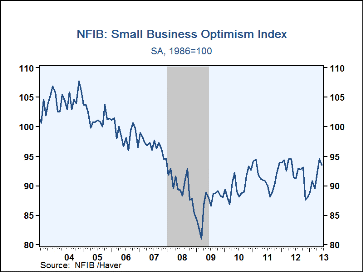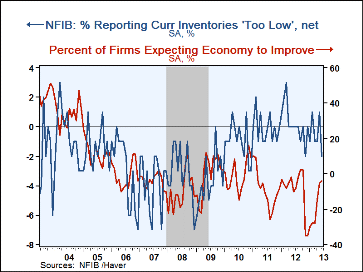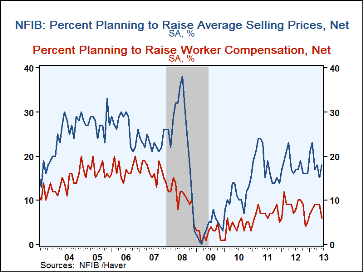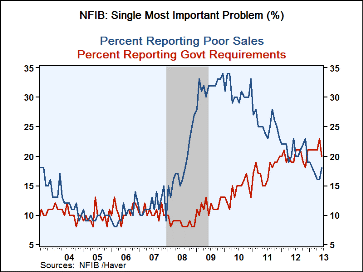 Global| Jul 09 2013
Global| Jul 09 2013U.S. Small Business Optimism Backpedals Somewhat
by:Tom Moeller
|in:Economy in Brief
Summary
The National Federation of Independent Business reported that its Small Business Optimism Index slipped during June to a seasonally adjusted 93.5 from 94.4 in May. The figure, nevertheless, was just below its highest level of the [...]
The National Federation of Independent Business reported that its Small Business Optimism Index slipped during June to a seasonally adjusted 93.5 from 94.4 in May. The figure, nevertheless, was just below its highest level of the economic expansion.
Moving down sharply was the percentage of firms reporting that inventories were too low. That percentage dropped to the smallest since 2010. Also lower was the percentage of firms expecting higher real sales as well as those expecting credit conditions to ease. Finally, after three years of increase, the percent of firms planning to make capital expenditures dropped. Working higher was the percentage of firms expecting the economy to improve. It rose to its best level since October. Finally, after four years of sharp decline, the percentage of firms indicating that credit was harder to get nudged up.
Evidence of improved pricing power was exhibited by the percent of firms raising average selling prices which moved to its highest level since August. Also, the percent planning to raise prices nudged up a bit. The percent of firms raising worker compensation slipped following three years of healthy increase but the percent planning to raise compensation dropped sharply.
The most important problems faced by small business were taxes (a sharply lower 20%), government requirements (20%), poor sales (18%), insurance cost & availability (9%), competition from large businesses (8%), quality of labor (6%), inflation (5%), cost of labor (4%) and financial & interest rates (2%).
Roughly 24 million small businesses exist in the U.S. and they create 80% of all new jobs. The typical NFIB member employs 10 people and reports gross sales of about $500,000 a year. The NFIB figures can be found in Haver's SURVEYS database.
Economy to Cruise at Speed Limit in 2013 and Accelerate Slightly in 2014 from the Federal Reserve Bank of Chicago can be found here.
| National Federation of Independent Business | Jun | May | Apr | Jun'12 | 2012 | 2011 | 2010 |
|---|---|---|---|---|---|---|---|
| Small Business Optimism Index (SA, 1986=100) | 93.5 | 94.4 | 92.1 | 91.4 | 92.2 | 91.4 | 89.9 |
| Firms Expecting Higher Real Sales In Six Months (Net %) | 5 | 8 | 4 | -3 | 2 | 3 | 1 |
| Firms Expecting Economy To Improve (Net %) | -4 | -5 | -15 | -10 | -9 | -9 | -1 |
| Firms With Positions Not Able To Fill Right Now (Net %) | 19 | 19 | 18 | 15 | 17 | 14 | 10 |
| Firms With Few or No Qualified Applicants For Job Openings (Net %) | 41 | 38 | 38 | 33 | 35 | 32 | 27 |
| Firms Reporting That Credit Was Harder To Get (Net %) | 6 | 5 | 7 | 7 | 8 | 10 | 13 |
| Firms Raising Avg. Selling Prices (Net %) | 8 | 2 | 3 | 3 | 4 | 5 | -12 |
Tom Moeller
AuthorMore in Author Profile »Prior to joining Haver Analytics in 2000, Mr. Moeller worked as the Economist at Chancellor Capital Management from 1985 to 1999. There, he developed comprehensive economic forecasts and interpreted economic data for equity and fixed income portfolio managers. Also at Chancellor, Mr. Moeller worked as an equity analyst and was responsible for researching and rating companies in the economically sensitive automobile and housing industries for investment in Chancellor’s equity portfolio. Prior to joining Chancellor, Mr. Moeller was an Economist at Citibank from 1979 to 1984. He also analyzed pricing behavior in the metals industry for the Council on Wage and Price Stability in Washington, D.C. In 1999, Mr. Moeller received the award for most accurate forecast from the Forecasters' Club of New York. From 1990 to 1992 he was President of the New York Association for Business Economists. Mr. Moeller earned an M.B.A. in Finance from Fordham University, where he graduated in 1987. He holds a Bachelor of Arts in Economics from George Washington University.










